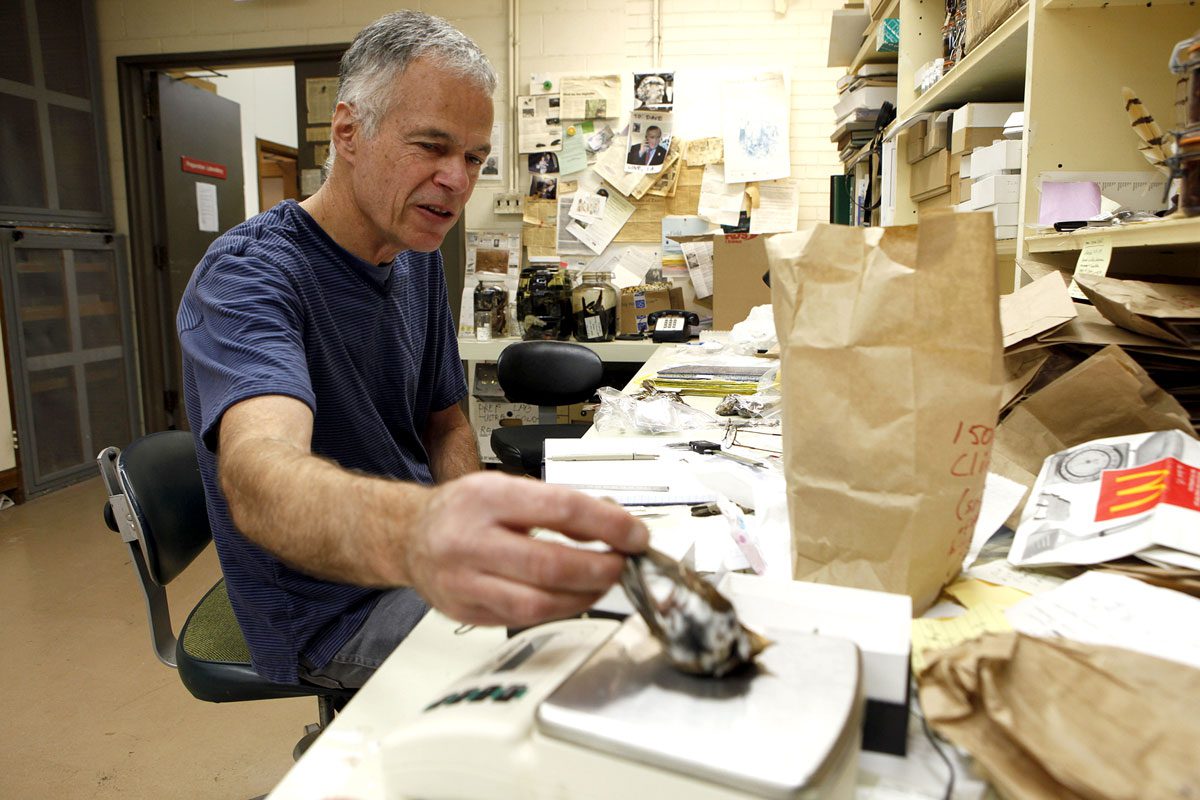The Ornithologist Who Helped Chicago’s Skyline Become Safer for Birds
March 30, 2020
From the Spring 2020 issue of Living Bird magazine. Subscribe now.
One morning in 1978, Dr. David E. Willard, a 32-year-old ornithologist at Chicago’s Field Museum, received a tip from a colleague about birds hitting windows at a nearby convention center.
“He just casually mentioned that birds sometimes run into McCormick Place,” Willard said. “So I just—out of curiosity—walked from the museum and kind of brazenly trespassed there.”
“I found a few birds that first time, and I lots of times wondered if I had found nothing that first time if I would ever have gone back,” he added.
Luckily for bird science, Willard did go back—every morning during migration for the next 38 years. From that first walk until 2016 (four years after his retirement as collections manager), he and his colleagues collected over 30,000 specimens of dead birds that had crashed into the glassy building with a huge facade along Lake Michigan.

A long-term research study was hardly at the forefront of Willard’s mind when he first began collecting specimens at McCormick Place. “I was thinking in terms of the museum,” he said. “I picked up a Yellow-billed Cuckoo and we didn’t have one in our collection.”
But since his retirement, Willard has coauthored papers drawing from his expansive data set, including a study on the link between bird night-flight calls and window strikes.
While many people think a skyscraper’s height is what’s fatal to migrating birds, Willard argues that McCormick Place—a vast but squat building, only about five stories high but spanning six city blocks—suggests otherwise: “I’m pretty convinced that it’s almost 100% about lights.”
Willard was not the first to connect Chicago’s bird collisions problem with the shining night lights of the Windy City’s skyline, but his findings helped to publicize the importance of dimming lights during migration. In the 1970s, Willard found that every year upwards of 2,000 birds were killed at McCormick Place during the spring and autumn migration seasons. But when the convention center started turning its lights out intermittently in the early 2000s, the number of window strikes decreased substantially to around 500 birds per year.
Willard’s work helped inform the other groups that work to reduce bird kills in the Windy City. Lights Out Chicago is a joint program managed by Chicago Audubon, the downtown Building Owners and Managers Association, and the city of Chicago to encourage buildings to shut off their lights during bird migration. And Chicago Bird Collision Monitors is a volunteer group that searches for dead or dazed bird victims of window strikes, treats injuries, collects data, and runs public outreach programs.
Although both programs have been highly effective (over 90% of Chicago’s high-rise buildings now turn out their lights during bird migration seasons), Willard believes the problem won’t be resolved until the design of these structures take birds into account.
“Building after building goes up that appears to have been designed to kill birds,” he said, referring to the architectural trend in glassy buildings. “There have to be laws and ordinances that require architects and designers to take birds into consideration.”

That was the idea behind the Bird-Friendly Design Ordinance, introduced into the Chicago City Council in 2019, that would require new or renovated buildings to incorporate designs and lighting practices that are safe for migratory birds. At press time, the ordinance still hadn’t moved out of the city council’s zoning committee.
Other bird-friendly building proposals have landed successfully in some of North America’s biggest cities. Toronto has a series of standards designed to prevent bird collisions and light pollution. In California, San Jose, San Francisco, and Oakland have all enacted bird-friendly building guidelines based on recommendations from the American Bird Conservancy. And in New York City—where NYC Audubon estimates up to 230,000 birds die annually from building collisions—a newly passed bird-friendly glass bill will take effect later in 2020 that requires all new building construction and renovations to use materials that reduce bird strikes.
All this legislative action may have seemed unthinkable just a few decades ago, when Willard took his first walk by McCormick Place.
But Willard won’t be caught taking too much credit: “If any of these monitoring things have anything to do with ours, it makes me glad to see the broader understanding of what’s going on.”
Benjamin Hack is a student in Cornell Arts & Sciences, class of 2023. Hack participated in a Cornell University science journalism course in Fall 2019 that was made possible with support from Jay Branegan (Cornell ’72) and Stefania Pittaluga.

All About Birds
is a free resource
Available for everyone,
funded by donors like you
American Kestrel by Blair Dudeck / Macaulay Library



